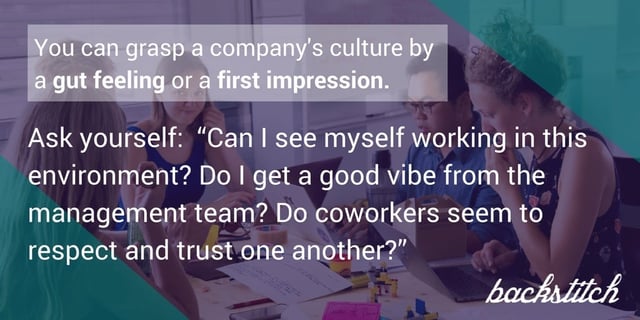Whenever someone interviews at an organization, “company culture” is an important factor that will likely impact the decision to take on a new role.
Company culture can be defined as the personality and environment of an organization. It consists of shared values, mission, ethics, priorities and expectations.
But is “company culture” anything more than a buzzword? What does it actually mean — and how can you distinguish good culture from bad culture?
Studies show that as the economy grows, the American workforce is increasingly more likely to value things like respect and harmony in the workplace — factors that contribute to an organization’s overall culture.
A 2015 report by the Society for Human Resource Management showed that workers today find trust between employees and management and respectful treatment of employees at all levels to be more important than compensation.
Many people can sense corporate culture by a gut feeling or a first impression. They ask themselves: “Can I see myself working in this environment? Do I get a good vibe from the management team? Do coworkers seem to respect and trust one another?”

Company culture is a hard concept to pin down. Although culture impacts every employee deeply, it's not something that is always obvious how you can measure scientifically. Instead, it's something you can feel.
Sure, you can get a sense of company culture by “feeling the vibe.” But, humans are not mind readers. Sometimes, we’re wrong. Sometimes, things can change and a company that once had a healthy culture might go south.
Here are some warning signs and red flags to look for that might signify that your company culture is out of shape. (Don’t worry, you can always turn it around!) 😀
1. Gossip

When coworkers gossip — about their boss, other departments or other members of their team — that’s one surefire sign there’s a culture problem.
Healthy communication habits are shaped by the internal processes that the organization uses to share messages with one another. Gossip is a sign that employees don’t feel as though direct communication is a reliable option. Ask yourself, what social norms might be provoking this poor behavior?
If you notice that gossip is becoming a more regular occurrence in the office, remind your team of the company’s shared mission and values. When employees remember that they’re all in this together, it becomes less intimidating to share candid, yet kind, feedback with one another openly.
2. Idle workers

Do you often find your employees sitting around, looking confused and bored while on the job?
This warning sign indicates that your organization’s culture has poor communication habits. When employees don’t have enough work to fill their time each day — or are left waiting on their supervisor or another department — this wastes company time and money.
Unfortunately, idle workers are pretty common. The University of Texas discovered that corporations waste about $100 billion per year on idle workers, who spend hours each week at work with nothing to do.
Workers seek passion and purpose, and too much idle time can make employees feel meaningless and replaceable. When this happens in the workplace, it is a sign that the organization needs to revitalize its routines and processes.
3. Low risk-tolerance

During team meetings and brainstorming sessions, fresh ideas ought to be encouraged.
You know the saying, “There’s no such thing as a stupid question?” This is especially important to keep in mind in the workplace. If companies want employees to bring their absolute best to the table, they’ll need to create an environment that breeds curiosity, adaptability and innovation.
If you notice that supervisors or colleagues are dismissing the ideas and input of others, this is a warning sign. (Especially when phrases like: “But this is how things have always been done around here!” are used often.)
4. High employee turnover

High turnover rate — especially among top performers — can be a glaring red flag that something in the work environment isn’t quite right.
Although turnover rate varies by industry, nobody wants to lose their top performers. A 2017 study by Gallup shows that happy workers are more likely to stay in their role, with highly engaged businesses obtaining 24 percent lower turnover rates on average.
Read: How to Switch your Mindset from Recruitment to Retention
Chances are, if your organization’s turnover rate is higher than average for your industry, it’s a culture problem. That same report showed that only 6 in 10 U.S. employees agree that their job expectations are clearly communicated by their supervisor.
Gallup estimates that ratio grew to 8 in 10, organizations would see a 14 percent reduction in employee turnover and 7 percent increase in productivity.
5. Unhappy customers or clients

The last red flag to look for is unsatisfied customers.
Generally, happy employees create happy customers and clients. And if the pile of complaints is getting too high, this could be a sign of toxic workplace culture
Unhappy customers and clients can be created due to an unhappy workforce, inefficient processes and poor communication.
If any of these signs sound like your organization, take this as an opportunity to establish a more cohesive, comprehensive internal communication strategy that engages your entire employee population. This can develop a culture of collaboration in the workplace.
You can use the comprehensive backstitch platform to send personalized messages across channels and analyze employee engagement metrics — so you can stay on top of your organization’s culture.


